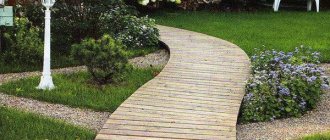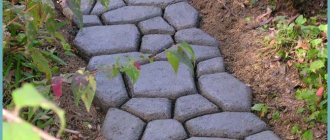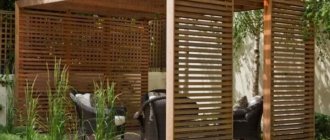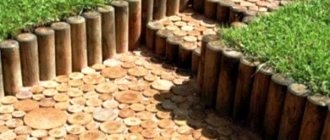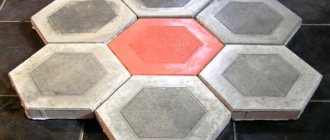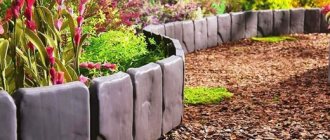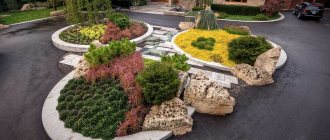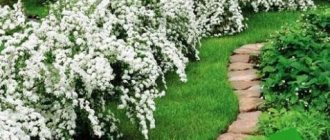Features of choice
There is nowhere in the country without garden paths, and sooner or later the inhabitants will trample narrow paths to the toilet, to the vegetable garden, to the barbecue. Only the quality of these paths will be much worse than any made by yourself. They:
- quickly overgrown with grass - once you return to the dacha after a long winter absence, you will find that the paths can no longer be found in the green thickets;
- are washed away by rain - as soon as the weather turns bad, and instead of paths you will have grooves filled with water, which are impossible to walk along.
DIY garden paths
Even with a small budget, it is necessary to make comfortable paths. There are many ways to do this.
Paths made of plastic
Plastic garden paths are perhaps the most economical and simple option. They usually have a size of 30x30 cm and are quickly and easily attached to each other. Also recently, plastic paving slabs have begun to appear. It does not require special installation, but is simply stuck into the ground, which is ideal for temporary paths.
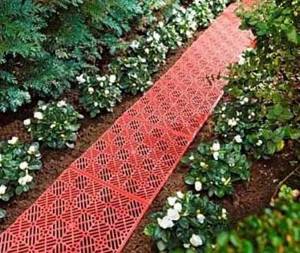
Bulk paths
As the name suggests, this group includes paths made of materials that are poured onto the ground. There are two such materials, each with its own pros and cons.
Gravel
It is inexpensive, and you can find it for free. Its advantages are the following:
- Lack of drainage . Gravel allows water to pass through perfectly, so you don't have to worry about the paths turning into streams when it rains.
- Lack of care . Gravel is reliable and durable. It does not need to be processed, it is not afraid of water, temperature changes, or pests. It can be washed by rain, and if something spills on it, you just need to stir it.
- Easy to repair . If something happens to your gravel path - for example, it settles - just add new gravel to make it look as good as when it was laid.
- Easy to install . Any material that looks like tiles needs to be laid out to make it look beautiful. Gravel is easy enough to pour.
- Bizarre forms . Using gravel you can make a path of any shape.
- Roughness . Even if it rains, the gravel path is difficult to slip on.
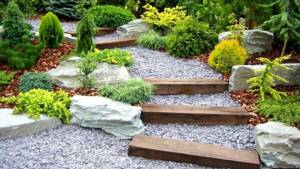
Using gravel you can make a path of any shape.
But, of course, they come with disadvantages:
- Monotony . The gravel is mostly gray, which is a pretty boring color. We'll have to come up with something to make it look more interesting.
- Inconvenience of walking . The gravel is sharp. If you step on it with bare feet, the sensations will not be pleasant - and in light summer slippers it can also be uncomfortable.
- Processing difficulties . Gravel is a bulk material. If you don’t clear the ground underneath it of seeds, grass will grow through it by spring. Sometimes this can be part of the design, but more often it is annoying and looks out of place.
Tip Instead of gravel, you can use crushed stone, crushed natural stone, even broken bricks and asphalt waste - anything that can be poured onto the path.
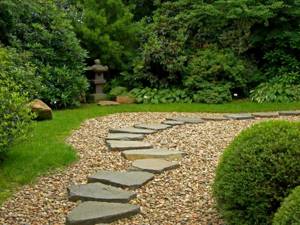
Gravel in landscape design
Bark
The material is original and natural. If you heat your dacha with wood, there shouldn’t be any problems getting it.
Its advantages are the following:
- Naturalness . In the depths of a green garden, such a path will look nice.
- Easy to install and repair . It’s not difficult to pour bark on the ground, but adding new bark if something happens to the old one is even easier.
- There is no need to prepare the land . The bark does not need drainage; it allows moisture to pass through. And there is no need to remove the weeds under it - it perfectly blocks their growth.
- Soil enrichment . The tree gradually rots, as a result of which the soil becomes more fertile - perhaps in a couple of years you will be able to plant a whole path of flowers that will decorate your garden.
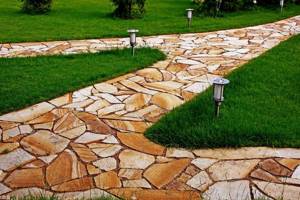
Cheap and beautiful - bark paths
But there are also disadvantages:
- Fragility . The tree rots from moisture and is eaten by pests. In a year, when winter has passed and the snow has melted, the bark paths will need to be laid out again.
- Difficulties in choosing the right bark . It should not be too small, otherwise it will quickly become unusable, and not too thick, otherwise it will be uncomfortable to walk. The bark of resinous trees will not work - it will constantly stick to your shoes.
Cora in the depths of the garden, where people rarely go.
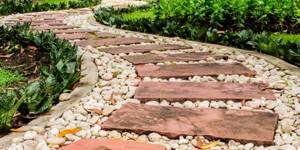
Choose materials to make them look beautiful
This will be interesting to you: REVIEW: Options for beautiful garden gazebos with your own hands (245+ Photos) - How to turn them into a real decoration? (wood, metal, polycarbonate)
Types of garden paths
Garden paths differ in material, size and pattern. The path should be chosen taking into account the style of the country house.
Paths on the site, depending on the type of material, can be:
- gravel;
- ground;
- brick;
- monolithic;
- end;
- tiled;
- crushed stone;
- herbal.
Each of them has its own advantages and disadvantages.
gravel paths
It is not advisable to use a gravel surface where a car or a mini garden tractor can drive. It is very difficult to remove fallen leaves from gravel, so in this case you can only use a special garden vacuum cleaner. Along with the disadvantages, we can also highlight the advantages of a gravel path:
- varied decor;
- resistant to wet weather (no blurring);
- long service life;
- easy installation.
If the load on the path is minimal, then gravel is an excellent budget solution.
Ground
Brick is the most common material used by builders, so laying brick paths is the most optimal and budget option. The path can be laid out in different ways and using different colors. A simple building brick for a walkway will not be very durable. It is better to use clinker bricks . It is made by firing special clay. This track will last a long time and does not require special care.
Monolithic
Monolithic garden paths are the most versatile. Because of their durability, they are in great demand among gardeners. They are made of monolithic concrete and are the simplest and most profitable material for summer residents. Concrete is treated with special chemicals. With its help, you can create various options for laying paths on the site.
End
End tracks are popular due to their environmentally friendly material . They are made from saw cuts, slices, boards or planks. Various mosaic options for laying the end path look great in the landscape design of a country house. It is pleasant to walk on and is not very slippery after rain. Before laying, the wood is treated with special protective agents so that the path does not rot over time.
From concrete slabs
A concrete slab walkway can be laid using materials of different sizes and colors. This will give the garden plot a unique appearance. To diversify the style of the site, concrete slabs are combined with brick or stone. Decorative concrete will cost 2 times more than regular concrete. It also needs to be looked after, as it can chip at the edges; every year the surface should be protected with a special varnish. If you do not take any measures to renew the surface, the path will lose its former beautiful appearance.
From crushed stone
Garden paths made of crushed stone can be chosen taking into account your individual preferences and the design of your country house. There is a large selection of color shades on the market that can be varied during installation. The advantages of a crushed stone path are that it can withstand heavy loads and there are no puddles left after rain. However, it is not advisable to lay paths made of marble and limestone in a place where there is shadow. Over time, the path may become covered with plaque, and this will ruin the appearance of the garden plot. In these places it is better to use paths made of quartz and granite.
grass paths
Grass paths are very aesthetically pleasing and look rich, but they require serious care. Unlike stone and concrete paths, they do not heat up in summer, absorb dust and contribute to the production of oxygen.
They can be used not only as pedestrian routes, but also as access routes, suitable for any design and style of garden plot, and come in various shapes and lengths. Meadow bluegrass, white bentgrass, meadow and red fescue and other plants that are resistant to trampling are usually used as seeds.
Recent Entries
Chainsaw or electric saw - what to choose for the garden? 4 mistakes when growing tomatoes in pots that almost all housewives make Secrets of growing seedlings from the Japanese, who are very sensitive to the soil
Disadvantages of these types of paths: inconvenience after rain (the ground gets wet and the grass path becomes wet), sooner or later bald spots remain and the path is trampled down. In the summer you will need to mow quite often. But these problems can be solved. To prevent trampling, you can use special lawn gratings that cope well with heavy loads and do not impede the growth of grass. To avoid inconvenience after rainy weather, you can lay a paved and concrete path next to the entrance to the fence.
Natural materials
If you love naturalness, you will definitely like one of these solutions.
Grass
Strange as it may sound, no one will stop you from planting grass for lawns on the paths. It has its advantages:
- Beauty . If you like ethnic styles or eco style, you will also like paths of lush green grass. They look nice, unusual, and attract the eye.
- Simplicity . Under the grass there is no need for drainage, not even a foundation. It is enough to simply dig up the ground, like digging up beds, and sow seeds into it.
- Coolness and atmosphere . The grass does not heat up like other paths and the area is not as hot in the summer. In addition, it produces additional oxygen - even if this is not very noticeable to a person, it still has an effect.
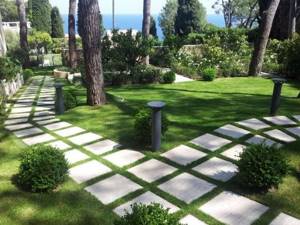
The choice for paths is very diverse
Also included are the disadvantages:
- Problems with care . If you can simply forget about most garden paths by laying them down, this will not work with grass. It needs to be pruned so that it does not grow, it needs to be watered so that it does not wither.
- Fragility . The grass needs to be re-sowed every year since it is mostly annual.
Advice You can buy special mixtures for lawns, or you can buy fescue, bentgrass, ryegrass or bluegrass seeds - they are also great.

Consider the subtleties of selection and installation
Tree
The material is beautiful, noble and cheap if you don't need expensive varieties or if you know where to get it.
Its advantages are the following:
- Beauty . Even paths slightly darkened by time remain beautiful, let alone those that have just been laid.
- Convenience . It’s pleasant to walk on wood, either barefoot or with shoes.
However, there are several more disadvantages:
- Difficulties with processing . In order for wood to serve for a long time, it must first be treated with compounds against pests, moisture, and temperature changes. And repeat this procedure every year.
- Relative fragility . Even with regular treatments, wooden paths do not last longer than ten years - constant contact with the ground does not benefit them.
- Difficulty of care. To keep wood looking good, it needs to be washed from time to time.
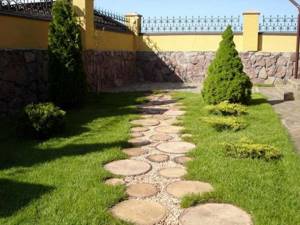
Don't forget to use sand as a pillow
There is no need to treat weeds under the tree, but you need to think about drainage and either leave gaps or make a special outflow of water.
You can place a tree on the ground in different ways - the effect will vary.
There are:
- Spili . Perhaps the simplest solution is that if you use firewood or if it’s high time to cut down something on your site, then it’s enough to simply cut round dies about five centimeters thick from the trunk. Then they are laid out on a bed of sand and look like round wooden tiles - interesting and original in their own way.
- Dies . About the same thing, but you need to cut not the trunk, but the boards, so that you get rectangles of the same size. They can be used instead of tiles, laying out geometric patterns from them. It looks interesting due to the fact that not a single die will repeat another - they will all have a unique color, unique veins.
- Boards . A simple solution, but beautiful at the same time. The boards are simply laid out on the path and its only drawback is that it can be either straight or curved at strict geometric angles.

Can be easily made by yourself
Advice If you have access to cheap wood, these paths will suit you. But it’s not really worth spending money on them; they have more disadvantages than advantages.
Stone
A real stone that can be found throughout the earth in huge quantities. Of course, you won’t get beautiful tiles from it, but the fragments can also look pretty good.
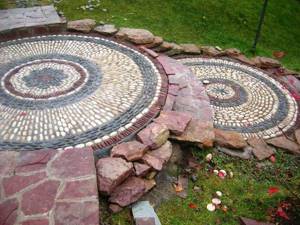
Paths made of natural materials
Its advantages are the following:
- Absolute reliability . The stone is not afraid of water, wind, insects, rodents, temperature changes, mechanical damage - by and large, it is not afraid of anything at all and can lie in place for centuries.
- Beauty . The stone is beautiful in its own way - with a strict, discreet beauty. It is suitable for lovers of minimalism, Buddhist philosophy and people who are not looking for flashiness.
- Space for imagination . Free-form pieces of stone can be difficult to arrange in a way that looks good. The greater the pleasure when the result is obtained.
- Lack of care . The stone is washed by rain and dried by the sun. And if you spill something on it, you can always use even aggressive chemicals.
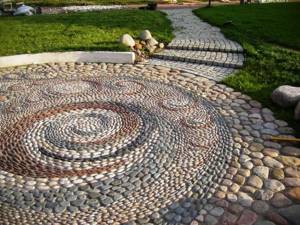
The stone is not afraid of wind, rain or sun
There are not too many disadvantages to the stone:
- Heaviness . Even under the fragments you will have to lay a decent layer of auxiliary material, otherwise the path will simply go into the ground very quickly.
- Texture . If you choose a smooth stone, it will be slippery when it rains.
- Monotony . The colors of the stone are muted, plus there are not very many of them. If you like bright colors, then finding something suitable among them can be difficult.
Advice Stone paths are good where there is a lot of walking and sometimes even driving.
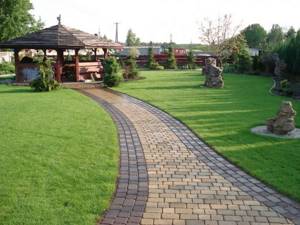
The color of the stone is mostly muted
Natural materials look good in all styles - although they have nothing to do next to an ultra-modern high-tech house, for example.
This will be interesting to you: REVIEW: Decorating Flower Gardens and Flower Beds with your own hands - 210+ (Photos) Original and beautiful designs
Artificial materials
If natural materials are good because they are natural and the way they look, then artificial materials have other advantages.
Concrete
He has this:
- Price . Among cheap materials, it is perhaps the cheapest.
- Simplicity . Concrete looks discreet and can be completely lost in the garden.
- Reliability . Not afraid of moisture, temperature changes, insects. It does not crack if you drop something heavy on it or try to drive a vehicle over it.

Concrete looks discreet and simple
Its disadvantages are mainly related to the filling process:
- Difficulty of manufacturing . It will be difficult to pour a concrete path for a person who has never done this the first time - after all, you need to prepare the base, make a curb, mix it correctly...
- Difficulty of repair . If the concrete cracks, it will have to be replaced entirely.
- Boring look . Concrete is mostly gray; it can only be diversified if you use additional materials for decoration.
Advice Filling paths with concrete makes sense in cases where aesthetics do not concern you, but whether you can drive a tractor along the path is a big concern.

Concrete is difficult to repair
Plastic
Plastic tiles have been produced for a long time and cost practically nothing. It is made from polyvinyl chloride and given different shapes.
Its advantages are the following:
- Variety . Plastic tiles come in different colors and textures. You can choose from it endlessly.
- Easy to install . The process of laying a path made of plastic tiles is similar to the process of laying a mosaic. One element is placed, another is attached to it, and so on until the entire path is completed.
- Texture . Plastic tiles are specially made so that even during rain it is impossible to slip on them.
- Drainage . As a rule, special holes are made in the tiles to drain water.

Plastic tiles for paths
Plastic is not afraid of moisture, temperature changes, and does not suffer from insects. You don’t need to take special care of it, just spray it with water from a hose.
But it also has disadvantages:
- Simplicity . Plastic tiles look worth their price and not every dacha will be able to fit them into the overall concept.
- Fragility . Despite the fact that plastic is not afraid of anything, over time it wears out and becomes unusable. This happens in about five years.
- Loss of color . If the path is located in the sun, over time it will fade and become faded.

Wood-look plastic
This will be interesting to you: REVIEW: Catalog of flowers for the garden (240+ Photos with names): All the rules for creating incredible beauty
Brick paths
For garden paths, it is better to take durable baked bricks. A 5 cm layer of crushed stone is poured onto the prepared and compacted bed; sand, also about 5 cm thick, is poured on top. It is thoroughly compacted, watered with water and compacted again. Bricks can be laid directly on this base with a gap of no more than 5 mm. Or you can apply a layer of cement mortar on top of the sand, and lay the brick on it.
It is better to start from the edge of the path. The pattern must be thought out in advance. Check each brick for level; it is better to drive them in with a rubber hammer and not too hard. The last stage of construction is filling the joints between the bricks. This is done with sand or dry cement mixture. Pour sand (mixture) onto the path and brush it over the surface. After this, water it with water from a watering can with a small mesh or a hose with a fine spray. The main thing is not to wash out the seams.
Brick is perhaps one of the best materials for garden paths. It is durable, does not fade and is frost-resistant. Using bricks of different colors and different masonry, you can lay out original patterns and shapes. Read more about brick paths.
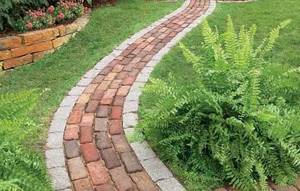
Available materials
In addition to materials that you need to buy, albeit inexpensively, or get through friends, there are also materials that you most likely already have on your farm.
Tires
If you have a car, then there should be a lot of tires that have fallen into disrepair. Therefore, they can be put to good use.
The advantages of this solution are the following:
- Saving . Giving a second life to something that has already served its purpose is always nice.
- Texture . The rubber is rough to the touch and you won't be able to slip on it even in the rain.
- Reliability . Rubber wears out for a long time - it is not afraid of moisture, temperature changes, or pests.
- Simple repair . If part of the track fails, it can be easily replaced.
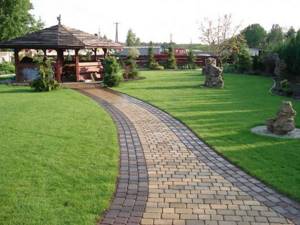
Paving a path in the garden with paving stones
Of course, it also has disadvantages:
- Difficulty with installation . To lay the tires, you need to make a base for them, provide drainage, cut each tire by hand... This will take time.
- Boring look . All tires are black, there are no colored ones. Therefore, the paths in the garden will be black, which is not particularly interesting or beautiful.
Making a track from tires is very simple - the tires are cut to form long strips. Then there are boards and strips are nailed to them - from one transverse board to the other. Afterwards, the entire structure is laid on a prepared sand base.
Advice Making a path out of tires only makes sense if you or one of your close relatives has a car. Otherwise, problems may arise in order to obtain new replacement tires.
Plastic bottles
If you are used to drinking lemonade or mineral water, you don’t have to throw away the bottles, but use them as material for the path. The advantages are as follows:
- Reliability . The plastic from which the bottles are made is not afraid of anything. It may only bend a little over the years of use, but it certainly won’t rot.
- Durability . A plastic bottle takes several decades to degrade. This is harmful for nature, but for a person who decides to make paths out of bottles, it is useful - they will last a very long time.
- Massage effect . Walking on the protruding bottoms of bottles is useful for preventing flat feet.
- Easy to repair and maintain . If one of the bottles becomes very wrinkled, it can be replaced. And there is no need to wash them at all, unless you spilled something that gets dirty.
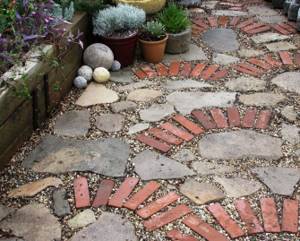
A little imagination and you get an interesting option
And, accordingly, the disadvantages:
- Difficulty in installation . Each bottle must be filled with sand and gravel, each must be buried by hand - this takes time and effort.
- Boring look . The bottles look worth their price - that is, cheap. To give them a beautiful look, you will have to try.
The technology for making a path from bottles is very simple.
Sand and crushed stone are poured into each bottle for weight. Then the bottles are dug into the ground where the path will be, bottoms up, at a short distance from each other. The whole thing is either sprinkled with sand on top or filled with concrete to create a relatively flat surface.
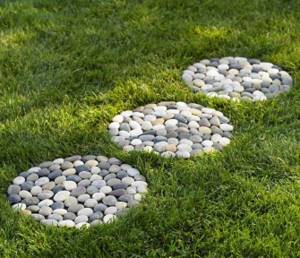
Mini paths - beautiful and creative
Tip To give the bottles a more interesting look, you can add colored sand to them.
Third - bottle caps. Their advantages are the following:
- Reliability . Like any plastic, they do not suffer from water, heat, cold and pests.
- Durability . Just like plastic bottles, they take decades to decompose.
- Brightness _ Using lids you can lay out pictures or patterns that will look interesting and original.
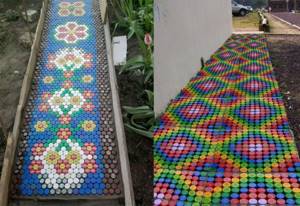
Plastic lid option
There are also disadvantages:
- Difficulty in installation . You will have to make an effort to put at least something out of the lids - this process is similar to putting together a mosaic and can take several days, or even weeks.
- Difficulty of preparation . You not only need to prepare a sand base, but also put concrete on it, into which the lids will be inserted. Moreover, this must be done sequentially, gradually, but pour more than fifty centimeters at a time, otherwise the concrete will dry out before you have time to lay out anything.

This method of laying out is quite troublesome.
Advice Under plastic covers, it is good to mark out one path along which few people walk and from which you can take your time. Then styling it will be a creative process and relaxation, not at all like in a hurry.
Nuances
In addition to the materials, it is also worth mentioning the rules by which paths are generally laid:
- Convenience . The path should be comfortable to walk on, and this is much more important than how it looks from the outside. Therefore, the best way to decide where it should be is to allow the inhabitants of the site to trample the paths on it, and then fill or fill them.
- Tortuosity . The paths don’t have to be straight - unless, of course, you want to make your place look like an English park. They should bend weirdly. This way they look much more beautiful.
- Width . It should not be less than seventy centimeters, otherwise even two people will not be able to pass on the path, and of course nothing will pass along it.
- Location. The paths should be located at least one and a half meters away from the nearest trees - or the branches should be carefully tied so that it is convenient to walk under them.
- Curbs . They are not at all necessary - paths made of grass or wood can do without them. But for bulk materials they are required. Otherwise, all the gravel or all the bark will very quickly spread all over the garden around.
- Laying . It is better to lay out paths in the fall, shortly before the rains begin. This strange timing is due to the fact that over the winter the path will shrink and become more suitable for walking. But this rule does not apply to bark and grass.
- Texture . If elderly people live on the site, you need to pay special attention to the texture of the paths. They should be impossible to slip on.
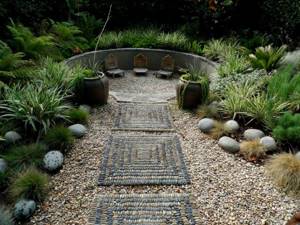
DIY garden mosaic
VIDEO: How to make a garden path on a budget?
Garden paths
Low Cost Options
